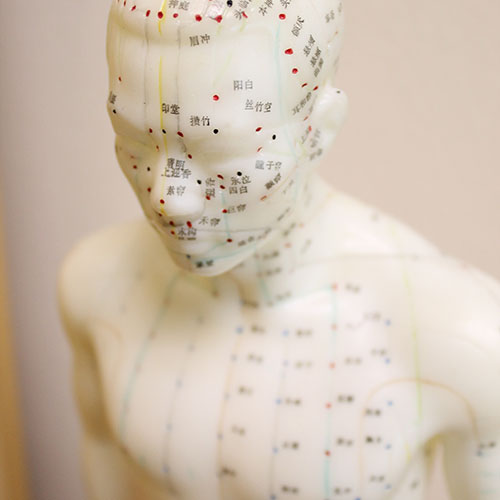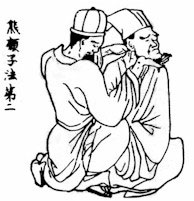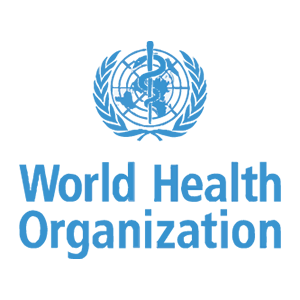Acupuncture is one of the branches of Traditional Chinese medicine. Acupuncture is the insertion of very fine needles, on the body’s surface, in order to influence physiological functioning of the body.
The needle insertion is based on the meridian system of the body. Chinese medicine believes there is a distribution network for the fundamental substances throughout the body. This distribution network called the Meridian System looks like a giant web, linking different areas of our body together. Its pathways make up a comprehensive yet complex body map that supplies nervous system communication and cell to cell signaling to every part of the body.
The meridian system is very similar to radio, in that radio waves likewise cannot be seen by the human eye, but we all understand they do, in fact, exist. Meridian acupuncture compares to radio in that if a city has 12 radio stations, much like our 12 meridians, it is imperative that each specific station broadcast at its individual frequency. In other words, if a station is operating at 94.5 on the dial, it comes in loud and clear; however, if it comes in at 94.4 or 94.6, the radio broadcast is only static. There is nothing wrong with the radio, it just needs to be tuned to the proper station. A simple adjustment to the radio will bring it into full normalcy.
This is what an acupuncture needle (meridian point stimulation) does. If a meridian is out of balance (out of tune) acupuncture can help bring that channel (meridian) back into balance allowing the signal to communicate properly with the rest of the network.

Acupuncture is one of the branches of Traditional Chinese medicine. Multiple modalities maybe utilized for patient care, including:
- Acupuncture needles
- Finger tip pressure
- Non-piercing needles
- Electrical stimulation
- Moxibustion
- Herbs
- Nutrition
- Tui na (massage/myofascial therapy)
- Diet
- Life style change
- Chiropractic
Ideally. Manual medicine is one of the branches of Traditional Chinese medicine. Spinal adjusting is part of acupuncture health care. World authorities, including Felix Mann, M.D., of England; Paul Nogler, M.D. of France; and Kunzo Nagayama, M.D., of Japan are very emphatic on this aspect of “getting well.” Dr. Mann states that many internal diseases are cured by the spinal adjustments alone. Leaving the adjustment (chiropractic) out of the treatment plan invites failure.

People experience acupuncture needling differently. Most patients feel only minimal pain as the needles are inserted; some feel no pain at all. Once the needles are in place, there is no pain felt.
Acupuncture needles are very thin and solid and are made from stainless steel. The point is smooth (not hollow with cutting edges like a hypodermic needle) and insertion through the skin is not as painful as injections or blood sampling. The risk of bruising and skin irritation is less than when using a hollow needle.
Because your doctor carefully sterilizes the needles using the same techniques as for surgical instruments, or uses disposable needles, there is no risk of infection from the treatments.
Yes. In the past 2,000 years, more people have been successfully treated with acupuncture than with all other health modalities combined. Today, acupuncture is practiced in Asia, the now disbanded Soviet Union, and in Europe. It is now being used more and more in America by patients and physicians.
Acupuncture treatments can be given at the same time as other techniques are being used, such as conventional Western medicine, osteopathic or chiropractic adjustments, and homeopathic or naturopathic prescriptions. It is important that your physician-acupuncturist know everything that you are doing, so he or she can help you get the most benefits from all your treatments.
No. Acupuncture is used successfully on cats, dogs, horses, and other animals. These animal patients do not understand or believe in the process that helps them get better. A positive attitude toward wellness may reinforce the effects of the treatment received, just as a negative attitude may hinder the effects of acupuncture or any other treatment. A neutral attitude (“I don’t know if I can really believe in this.”) will not block treatment results.
Usually not. As energy is redirected in the body, internal chemicals and hormones are stimulated and healing begins to take place. Occasionally the original symptoms worsen for a few days, or other general changes in appetite, sleep, bowel or urination pattern, or emotional state may be triggered. These should not cause concern, as they are simply indications that the acupuncture is starting to work.
It is quite common with the first one or two treatments to have a sensation of deep relaxation or even mild disorientation immediately following the treatment. These pass within a short time, and never require anything more than a bit of rest to overcome.
Yes. To enhance the value of a treatment, the following guidelines are important:
- Bring any previous reports, blood work, diagnotics exams, x-rays, MRIs, etc.
- Wear loose fitting clothing.
- Do not eat an unusually large meal immediately before or after your treatment.
- Do not over-exercise, engage in sexual activity, or consume alcoholic beverages within six hours before or after treatment.
- Plan your activities so that after the treatments you can get some rest, or at least not have to be working at top performance. This is especially important for the first few visits.
- Continue to take any prescription medicines as directed by your regular doctor. Substance abuse (drugs and alcohol) especially in the week prior to treatment, will seriously interfere with the effectiveness of the acupuncture treatments.
- Remember to keep good mental or written notes of what your response is to the treatment. This is important for your doctor to know so that the follow-up treatments can be designed to best help you and your problem.
A thorough medical evaluation and medical workup is recommended for health, healing and performance enhancement. Please consult your physician as applicable.
The World Health Organization (WHO) on Acupuncture
The use of acupuncture has been shown to effectively treat many types of conditions. In 2003 the World Health Organization (WHO) and the National Institutes of Health (NIH) released a report called “Acupuncture: Review and Analysis of Reports on Controlled Clinical Trials.” Below you will see a partial list of the symptoms, syndromes, disease processes, pathologies, traumas and conditions mentioned in that report.
Please note that there are plenty of additional conditions which centuries of empirical data have shown acupuncture treats effectively but for which there is little or no modern western research. If you have questions about a condition not listed below, be sure to contact us so we can address your specific situation.

Psychological Conditions
- Depression
- Anxiety
- OCD
- PTSD
- Somatization disorder
- Hypersomnia
- Insomnia
Respiratory System Conditions
- Acute sinusitis
- Acute rhinitis
- Common cold and allergies
- Acute tonsillitis
- Acute bronchitis
- Bronchial asthma
Conditions of the Eye, Ear, Nose & Mouth
- Acute conjunctivitis
- Central retinitis
- Myopia (in children)
- Cataract (without complications)
- Toothaches, post extraction pain
- Gingivitis
- Temporomandibular dysfunction
- Acute and chronic pharyngitis
- Allergic rhinitis (including hay fever)
Cardiovascular Conditions
- Essential hypertension
Neurological Conditions
- Headache and migraine
- Trigeminal neuralgia
- Facial palsy (early stage, within three to six months)
- Facial pain (including craniomandibular disorders)
- Paresis following stroke
- Peripheral neuropathies
- Meniere’s Disease
- Nocturnal enuresis
- Cervicobrachial syndrome
- Neurogenic bladder dysfunction
- Intercostal neuralgia
- Disc problems
- Radicular and pseudoradicular pain syndrome
- Raynaud syndrome, primary
- Reflex sympathetic dystrophy
Gynecological Conditions
- Infertility
- PMS
- Dysmenorrhea
- Menopause syndrome
- Benign irregular menstruation
- Benign amenorrhea
- Polycystic ovary syndrome (Stein-Leventhal syndrome)
Other Conditions
- Withdrawal from street and pharmacological drugs
- Appetite suppression
Musculo-skeletal Conditions
- Muscle pain, swelling, stiffness and weakness
- Localized traumatic injuries, sprains, strains, tendinitis, contractures
- Arthritis
- Fibromyalgia
- Rheumatoid arthritis
- Work and sports related injuries
- Low back and/or neck strain
- Osteoarthritis
- Gouty arthritis
- “Frozen shoulder”, “tennis elbow”
- Sciatica
- Knee pain
Gastrointestinal Conditions
- Spasms of esophagus and cardiac
- Irritable bowel and colitis
- Gastroptosis
- Acute and chronic gastritis
- Gastric hyperacidity (i.e. acid reflux)
- Chronic duodenal ulcer (pain relief)
- Acute duodenal ulcer (without complication)
- Acute and chronic colitis
- Constipation
- Diarrhea
- Acute bacillary dysentery
- Paralytic ileus
- Nausea and vomiting
